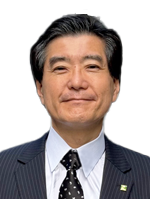Background to the "Development of the 19 Initiatives Starting from the 80th Anniversary of the Atomic Bombings" on Hiroshima
Shiro Tani
Vice-Chairperson, Hiroshima Peace Culture Foundation

Shiro Tani
Vice-Chairperson, Hiroshima Peace Culture Foundation
This article presents key perspectives underlying the "Development of the 19 Initiatives Starting from the 80th Anniversary of the Atomic Bombings", compiled by the Hiroshima Peace Culture Foundation. (Please note that any opinions expressed herein are those of the author.)
This vision is accompanied by the subtitle "To Fulfill the Role Expected of Hiroshima as a City Symbolizing World Peace."
Many "peace-loving cities and citizens" both in Japan and abroad have expressed their desire to pursue peace in solidarity with Hiroshima by showing sympathy for Hiroshima, which has recovered from the inhumane devastation caused by the atomic bombing and continues to strive for peace (see to "Hiroshima as Seen from the World" by Michihiro Nobumoto).
This subtitle reflects Hiroshima's commitment to appropriately fulfilling a leading role as a city symbolizing peace, with the participation of many Hiroshima citizens.
In this context, the vision outlines two major approaches to embody Hiroshima's role.
The first approach is raising international public opinion toward the abolition of nuclear weapons.
This perspective is based on the belief that the humanitarian initiative, which has provided a strong argument, must continue to be at the center of all international discussions on nuclear disarmament. Ambassador Alexander Kmentt, Director of the Disarmament at the Austrian Ministry of Foreign Affairs and Chair of the First Meeting of States Parties to the Treaty on the Prohibition of Nuclear Weapons (TPNW), emphasized the importance of the humanitarian initiative in nuclear disarmament by stating: "The Humanitarian Initiative has shown that the more the nuclear weapons discourse is opened up to include other voices, in particular from a humanitarian perspective, the stronger the impact is on this discourse. ... 'Deflection' from the humanitarian consequences and risk arguments [that] proved such a counterproductive tactic for the nuclear weapon States before the TPNW was adopted, ... It is much harder to grip the more fundamental questions relating to the sustainability and ethical defensibility of nuclear deterrence, in view of the humanitarian consequences and risks of nuclear weapons. ... What was initiated as a successful 'humanitarian reframing' of the nuclear weapons issue, was not continued sufficiently after the TPNW was adopted. It will be necessary for the TPNW supporters to refocus on this aspect."
This humanitarian initiative - the idea that the only way to ensure the survival of humanity is through the abolition of nuclear weapons - has its roots in the experiences of the atomic bombings of Hiroshima and Nagasaki. In this regard, the Nobel Committee explained the reason for awarding the Nobel Peace Prize for 2024 to the Japan Confederation of A- and H-Bomb Sufferers Organizations (Nihon Hidankyo) as follows: "In response to the atomic bomb attacks of August 1945, a global movement arose whose members have worked tirelessly to raise awareness about the catastrophic humanitarian consequences of using nuclear weapons. Gradually, a powerful international norm developed, stigmatising the use of nuclear weapons as morally unacceptable. This norm has become known as "the nuclear taboo". The testimony of the Hibakusha - the survivors of Hiroshima and Nagasaki - is unique in this larger context.
Meanwhile, Mr. Kiyoshi Tanimoto, who engaged in extensive testimony activities in the United States immediately after the war, wrote in connection with the (Hiroshima) Peace Center initiative "We must develop ways to make a lasting contribution to world peace based on our own experiences of the atomic bombing" and "Although we have sufficient emotional appeal, we do not yet possess the universal principle to express it powerfully." Today, the humanitarian initiative is a concept endorsed by over 180 nations, and it is precisely the kind of "universal principle" that Mr. Tanimoto identified as lacking.
For this reason, Hiroshima's role in linking the factual reality of the atomic bombings to the principle of the humanitarian initiative and instilling in people around the world the conviction that nuclear weapons must be abolished is becoming all the more vital.
The first approach is raising international public opinion toward the abolition of nuclear weapons.
This perspective is based on the belief that the humanitarian initiative, which has provided a strong argument, must continue to be at the center of all international discussions on nuclear disarmament. Ambassador Alexander Kmentt, Director of the Disarmament at the Austrian Ministry of Foreign Affairs and Chair of the First Meeting of States Parties to the Treaty on the Prohibition of Nuclear Weapons (TPNW), emphasized the importance of the humanitarian initiative in nuclear disarmament by stating: "The Humanitarian Initiative has shown that the more the nuclear weapons discourse is opened up to include other voices, in particular from a humanitarian perspective, the stronger the impact is on this discourse. ... 'Deflection' from the humanitarian consequences and risk arguments [that] proved such a counterproductive tactic for the nuclear weapon States before the TPNW was adopted, ... It is much harder to grip the more fundamental questions relating to the sustainability and ethical defensibility of nuclear deterrence, in view of the humanitarian consequences and risks of nuclear weapons. ... What was initiated as a successful 'humanitarian reframing' of the nuclear weapons issue, was not continued sufficiently after the TPNW was adopted. It will be necessary for the TPNW supporters to refocus on this aspect."
This humanitarian initiative - the idea that the only way to ensure the survival of humanity is through the abolition of nuclear weapons - has its roots in the experiences of the atomic bombings of Hiroshima and Nagasaki. In this regard, the Nobel Committee explained the reason for awarding the Nobel Peace Prize for 2024 to the Japan Confederation of A- and H-Bomb Sufferers Organizations (Nihon Hidankyo) as follows: "In response to the atomic bomb attacks of August 1945, a global movement arose whose members have worked tirelessly to raise awareness about the catastrophic humanitarian consequences of using nuclear weapons. Gradually, a powerful international norm developed, stigmatising the use of nuclear weapons as morally unacceptable. This norm has become known as "the nuclear taboo". The testimony of the Hibakusha - the survivors of Hiroshima and Nagasaki - is unique in this larger context.
Meanwhile, Mr. Kiyoshi Tanimoto, who engaged in extensive testimony activities in the United States immediately after the war, wrote in connection with the (Hiroshima) Peace Center initiative "We must develop ways to make a lasting contribution to world peace based on our own experiences of the atomic bombing" and "Although we have sufficient emotional appeal, we do not yet possess the universal principle to express it powerfully." Today, the humanitarian initiative is a concept endorsed by over 180 nations, and it is precisely the kind of "universal principle" that Mr. Tanimoto identified as lacking.
For this reason, Hiroshima's role in linking the factual reality of the atomic bombings to the principle of the humanitarian initiative and instilling in people around the world the conviction that nuclear weapons must be abolished is becoming all the more vital.
The second approach is the promotion of peace education for younger generations both in Japan and abroad.
This perspective is based on a sense of urgency that, amid the rapid aging of the hibakusha and other war survivors not only in Hiroshima but all across Japan, unless we promptly establish a system for educating the younger generation about peace, it may become difficult for civil societies to maintain the fundamental principle of valuing peace that these people have long upheld.
Another important point is that on-site learning is essential for peace education to be truly effective. This is why promoting peace education both domestically and internationally is considered a key role of Hiroshima. In his book, Tamotsu Eguchi, a pioneer in organizing school excursions to Hiroshima 50 years ago, cited the words of poet Sadako Kurihara: "Through careful preparations, including teachers' field studies and advance visits, and the students' active participation, the school excursion to Hiroshima became a great dramatic event. By participating, the students were mentally exposed to the atomic bomb. They came to regard the issue of nuclear weapons not as someone else's problem but as their own and learn the importance of life, human rights, and peace." This is consistent with the findings of a survey conducted last year on school excursions to Hiroshima. It revealed the process of shift in awareness: students who, before visiting Hiroshima, had only a vague understanding of the atomic bombing, came to realize that it had actually happened. This realization led them to understand that a peaceful daily life is not something to be taken for granted, but something that must be cherished.
In this context, a large peace education program, Hiroshima Peace Study Acceptance Program, is scheduled to take place in Hiroshima around August 6 this year, with approximately 2,100 people, including children from across Japan. As a symbol of friendship and shared commitment to peace, over 100 peace-loving cities from all over Japan that will participate in solidarity with Hiroshima will be presented with a "Peace Ticking Clock" made from pruned branches of atomic-bombed trees that have lived since 80 years ago.
In addition, discussions have begun regarding the development of a "peace education exhibit for children" at Hiroshima Peace Memorial Museum, which is scheduled to open in April 2028.
This perspective is based on a sense of urgency that, amid the rapid aging of the hibakusha and other war survivors not only in Hiroshima but all across Japan, unless we promptly establish a system for educating the younger generation about peace, it may become difficult for civil societies to maintain the fundamental principle of valuing peace that these people have long upheld.
Another important point is that on-site learning is essential for peace education to be truly effective. This is why promoting peace education both domestically and internationally is considered a key role of Hiroshima. In his book, Tamotsu Eguchi, a pioneer in organizing school excursions to Hiroshima 50 years ago, cited the words of poet Sadako Kurihara: "Through careful preparations, including teachers' field studies and advance visits, and the students' active participation, the school excursion to Hiroshima became a great dramatic event. By participating, the students were mentally exposed to the atomic bomb. They came to regard the issue of nuclear weapons not as someone else's problem but as their own and learn the importance of life, human rights, and peace." This is consistent with the findings of a survey conducted last year on school excursions to Hiroshima. It revealed the process of shift in awareness: students who, before visiting Hiroshima, had only a vague understanding of the atomic bombing, came to realize that it had actually happened. This realization led them to understand that a peaceful daily life is not something to be taken for granted, but something that must be cherished.
In this context, a large peace education program, Hiroshima Peace Study Acceptance Program, is scheduled to take place in Hiroshima around August 6 this year, with approximately 2,100 people, including children from across Japan. As a symbol of friendship and shared commitment to peace, over 100 peace-loving cities from all over Japan that will participate in solidarity with Hiroshima will be presented with a "Peace Ticking Clock" made from pruned branches of atomic-bombed trees that have lived since 80 years ago.
In addition, discussions have begun regarding the development of a "peace education exhibit for children" at Hiroshima Peace Memorial Museum, which is scheduled to open in April 2028.
